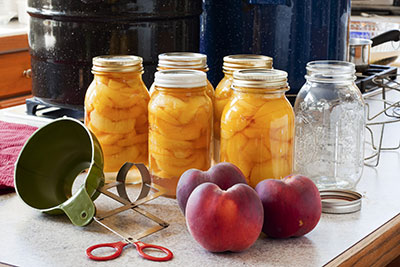Know How to Preserve Your Harvest With These 10 Tips
Increased interest in self-reliance has brought renewed attention to home food preservation. Canning is a great way to put up a shelf-stable supply of delicious, healthy fruits and vegetables when your garden is producing more than you can eat. Follow these basic tips to get started with confidence.
1. Use Jars Designed for Canning
Resist the urge to reuse glass jelly jars to can your food. These are thinner than the jars designed for at-home food preservation and may crack. Instead, look for jars specifically designed for this purpose, commonly called mason jars.
2. Use Fresh, Ripe Ingredients
You always want to start with the freshest ingredients that are picked at the peak of ripeness. Food will not ripen during the canning process and overripe food might contain harmful bacteria.

3. Adjust Water Level
Ensure proper water levels for the jars you are using. For water bath processing, cover jars by at least an inch. Pressure canners can use less water.
4. Follow Tested Recipes
Canning recipes are tested to ensure that every ingredient reaches the right temperature. This prevents spoilage and keeps you safe. There are plenty of tested recipes available so you can find one that suits your tastes.
5. Check for Cracks
Even a tiny, hairline crack in a jar can ruin an entire batch when subjected to the heat inside a canner. Inspect each jar as you wash it. Get rid of any that have chips or cracks to be safe.
6. Avoid Browning
Ascorbic acid, or vitamin C, and citric acid can be used on foods like apples and pears that are prone to browning. Look for it in the canning section of your local store.
7. Boil Water Vigorously
You must ensure that water reaches the temperature that is required for your food. This is necessary to kill harmful bacteria and microbes that cause spoiling. In a water bath process, that means a sustained vigorous boil.
8. Leave Headspace
You must leave some space in jars for expansion during the canning process. This is called headspace. Your recipe will tell you how much room your food needs.
9. Use the Proper Method
High acid foods like tomatoes and most fruits can be safely processed in a water bath. A pressure canner must be used for others. Stay safe by always using the recommended method.
10. Use the Right Size Jars
Some foods can be safely canned in large jars, while others need smaller quantities to process safely. Always use the jar size recommended in your recipe for the best results.
By following a few basic tips for canning, you can set aside an abundant supply of food to last throughout the winter. This way you never have to go without that fresh-from-the-garden taste.